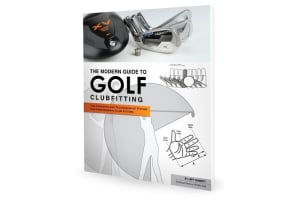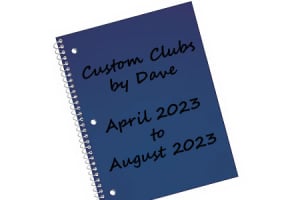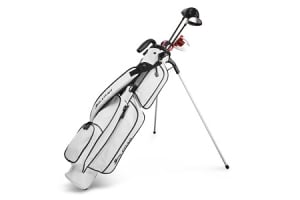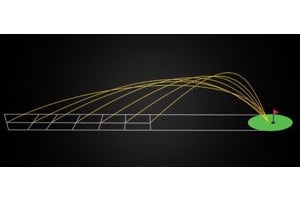Clubmaking
- September 15, 2021
5 Useful Tips for Fitting a Golf Club
Golfers reach out to me every day about what type of equipment is best for their game. In cases where it is over the phone or an email and you can't see the player hit clubs in person, one must rely solely on what the customer says. Here are some tips that will help you self-fit and find what you need more efficiently.
Write it Down
One of the best tips I can give is to take good notes. For instance, your golfing buddy let you hit his brand-new driver and you go "Holy cow, I really liked that!" Or perhaps, you went to a Demo Day and just beat the snot out of a driver. What really did you like better than what you are currently playing?
Line it up with your driver. Was it longer? Did it have greater or less loft? Look at the numbers on the heel or sole. What shaft and flex did it have?
- August 25, 2021
Pros and Cons of sanding a graphite shaft to fit a taper tip hosel
From time to time, I get the question from a clubmaker or hobbyist if it is alright to sand down the tip of a 0.370" parallel tip graphite shaft to fit into a 0.355" taper tip iron or wedge. Before I answer the question and show what the pros and cons are, I first must mention the liability issue. Anything you build or repair, you are liable for what happens. Therefore, it is always the best practice to put in the shaft size that corresponds to the inside hosel diameter.
Why would you need to sand the shaft?
The number 1 reason why clubmakers ask is due to the lack of taper tip graphite iron shaft offerings. Of the models that are available also tend to be on the more expensive side and likely a special order, requiring additional time to fix or retrofit a customer's club.
- May 07, 2021
Hireko Golf Grip Sizing Calculator
Let's face it, grip sizing can be confusing. It is a battle converting between fractions like 1/32" and +1/16" and decimal readings for butt diameters such as 0.580" and 0.600". The Hireko Golf Grip Sizing Calculator can tackle this problem and assist you in only a few simple steps by showing you what the final grip size will be in your club assembly or when re-gripping. All you need to do is enter the grip core size, shaft butt diameter, starting grip size and how many wraps of build-up tape you may want to add (if any). Click the Calculate button and presto...you instantly have your answer!
- April 22, 2021
So, you do not have a swingweight scale? No problem! We have provided you with three Hireko Golf Swingweight Calculators to provide you with the information you are looking for. These are fast, fun...and best of all, free! Input a few variables into the calculators and presto, you have your results.
- March 25, 2021
Golfers are constantly looking to increase the distance they hit the ball. One way is reducing the overall weight of the club so it can be swung faster and that is mainly a function of the shaft weight. But re-shafting to a lighter weight shaft does have some consequences.
What happens to the swing weight with a lighter weight golf shaft?
Some golfers assume if the shaft is lighter, a higher percentage of the weight is concentrated near the head resulting into an increase in swing weight (or spelled swingweight). However, that is not the case and let us show you why. If you look carefully at a golf swing weight scale, there is a fulcrum point or position that club pivots around located 14" from the end of the grip. That is a constant.
- February 26, 2021
You may find from time to time that a customer is caught between two flexes. There is a way to remedy this situation called the principles of soft and hard stepping shafts. These terms mostly apply to taper tip steel iron shafts, but the concept also applies to parallel tip shafts. So, let us explain each of the four scenarios.
SOFT STEPPING
Parallel tip shafts
Let us begin with the easiest example using parallel tip shafts. The flex of a unitized, parallel tip shaft is determined by how much to trim off the tip of the shaft based on the weight of the head. As head weight increases, the amount of tip trimming increases incrementally to maintain the flex the manufacturer designed into the shaft.
- December 29, 2020
One task a clubmaker will encounter is replacing a shaft into a club which has an adjustable shaft adapter sleeve whether it is to replace a broken shaft or upgrade to a shaft that better fits the customer. Most name brand drivers as well as many fairways and hybrids will offer this feature to be able to change the lie, face angle and "effective loft" of the club. While there is an extra piece involved, the basic principles of re-shafting remain the same with only a few exceptions.
- November 06, 2020
When you need the club now!
When it comes to epoxy, clubmakers have a choice between slow and fasting curing epoxies. Slow cure epoxy typically fully cures to safely hit a ball in 20 to 24 hours at a normal room temperature. On the other hand, fast curing epoxy can come to full cure in approximately 30 minutes.
Fast curing (or setting) epoxies have come a long way. Chemical manufacturers are able to produce higher shear strength, fast curing epoxies, which appeals to clubmakers as an effort to save time during the assembly process and to establish a rapid turnaround time for their customers in this day age.
- September 16, 2020
Where do I find shaft trimming instructions?
For those customers who were familiar with our website, you may have noticed a few changes. One is where you will access the shaft trimming guide which will now be now tucked under the main menu Golf Components > Technical. Now the appearance may be different but have no fear the fundamentals remain the same.
For those new customers, we want to welcome you and make sure you also know where and how to use the recommended tip trimming. For a tutorial on how to use our tip trimming guide we have a new updated page by going to the following link.





